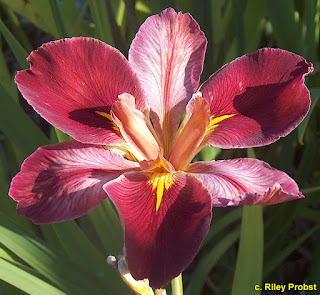By Bonnie Nichols
“What are Novelty irises?” ………. I get this question almost every judges training class I teach. I tell everyone “according to the AIS Handbook for Judges” – Novelties are broken color, space age, flatties, and variegated foliage irises. That statement is somewhat still true; however, the advancement of Novelty irises is moving rapidly. Remember when we all had dial-up modems and we heard whispers of “the Internet” circulating. And look where we are today!
'Big Bang Theory'--image by Blue Jay Garden
An example of new directions in Space Age irises.
'Zebra Blues' (Kasparek)--image by Jeanette Graham
An example of the new variegated foliage varieties.
In the 1950-60s “space age” irises became available to iris gardens primarily thanks to Lloyd Austin. Traditionalists probably shied away for these new-fangled irises. Strange irises, rock-n-roll, and the Beatles – what was the world coming to?
'Cross the Line' (M. Sutton)--image by Jeanette Graham
Space Age irises met some of the new color patterns.
Thanks to Alan Ensminger and Brad Kasparek (two guys that were iris pioneers), they brought us all those strange broken colors. Brad and Kathy Kasparek kept us guessing how to pronounce the GNU series as well as others.
'Spiced Tiger' (Kasparek)--image by Schreiner's Iris Garden
'Big Break'--image by Paul Black
Broken colors are now coming from different breeding lines.
'Leprechaun's Trick' (Black '15)--image by Paul Black
Another example of variegated foliage
Monty Byers gave the iris world three Dykes Medal Winners (Mesmerizer, Conjuration, and Thornbird). Many times I wonder what Monty would think about the advancements in space age irises since the late ‘80s.
'Tropical Delight' (M. Sutton)--image by Mike Sutton
So, in addition to quoting the AIS Handbook answer of what Novelty irises are…………I always add FLATTIES, DOUBLES, BROKEN COLOR, SPACE AGE, FLOUNCES, POMPOMS, FULL MOONS….and, and, and……….. I don’t know where iris forms and iris colors will go from here AND that is part of the fun too. So to everyone reading this, think about hybridizing more Novelty irises!
FLATTIES are probably my favorite. Did I say that out loud? As judges, we are trained not to show our personal preferences when judging. As a human I find that difficult especially when I’m adding irises to my personal collection. My favorites are CHAOS THEORY, ORBISON, TOP DOWN, and FULL DISCLOSURE. All are faithful flatties.
'Chaos Theory' (Blyth)--image by Barry Blyth
There is a new addition to my favorite flatties – WICHITA FALLS. Yes, you are one of the first to hear. Z.G. Benson’s granddaughter has been kind enough to share one of Z. G.’s seedlings from the early 1970s. It is a huge blue/yellow FLATTIE. It is 100% flat! She is allowing Hooker to distribute the iris for Z. G. and name it WICHITA FALLS.
'Wichita Falls' (ZG Benson)--image by Hooker Nichols
Wichita Falls is the town in northwest Texas where Mr. Benson lived and hybridized the iris. The Novelty Iris Society will introduce the iris. Novelty Iris Society members will be notified when the iris is available for sale. Proceeds of the iris sales will benefit the Novelty Iris Society.
'Full Disclosure'--Image by Andi Rivarola
'Top Down' (Nichols)--image by Hooker Nichols
Editor's Note: We appreciate Bonnie Nichols's guest blog. Bonnie is the president of The Novelty Iris Society and you can find more information about that group on Facebook as Novelty Iris Society.













































